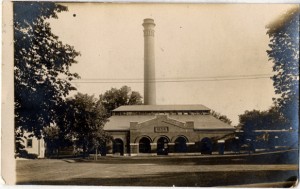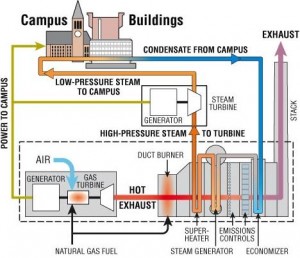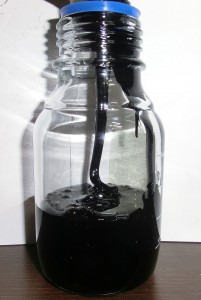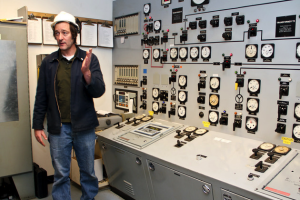Overview
Location: The Hanover Heating Plant is located at 6111 McKenzie Hall in Hanover, NH on the campus of Dartmouth College.
Objective: The purpose of visiting the plant was to enhance our knowledge of the landscape of infrastructure specifically in New England in order to understand how places like the heating plant connect to the functionality of large businesses and campuses such as Dartmouth. The comprehension of the role that the plant plays helps to bolster its value in the Hanover and Dartmouth communities.
The Heating Plant: History and Development
The Dartmouth Heating Plant started in 1898, making it the oldest continuously operating co-generational energy plant in the country. Although there have since been renovations, the power plant still works out of the original building with the original boiler room and granite foundation. The original 1898 stack was replaced in 1958. This all brick, 175-foot structure is a prominent feature of the building, and an important instrument to measure the amount of smoke leaving the building. There is a platform in the middle of the stack used to monitor the opacity of the smoke. The heating plant was created for the purpose of providing heat and hot water to campus. Today, in addition to heat and hot water, the plant provides up to forty percent of the campus’ electricity during the winter months. The plant operates 24 hours a day all year long to provide heat, electricity, hot water, and even facilitate the distribution of air conditioning to a few buildings during the summer months. The heating plant continues to add new equipment in order to keep up with the additions of new buildings on campus. Today the plant includes four boilers and three turbine generators.
Cogeneration: Heat and Electricity Production
The Hanover Heating Plant has been supplying Dartmouth’s campus since 1903. The plant’s main purpose is to provide steam in order to supply the campus with electricity and heat by sending low-pressure steam around campus. The energy from the steam produced (thermal energy) is turned into mechanical energy in the turbine, which then turns a generator producing energy that is utilized on campus as electricity. 90% of the steam that is sent out to campus for things such as heat and hot water returns to the plant in the form of condensation; the other 10% is lost and must be replaced. Throughout the cogeneration process the heating plant supplies campus with up to 40-45% of the electricity it consumes annually.
Oil in Boiler -> Creates Steam -> Turn Turbine -> Electricity & Steam -> Steam to Campus
Why No. 6?
Produced by mixing residual oils from the refinement process most commonly with No. 2 oil, No. 6 fuel oil is characterized by its extremely thick, sticky, dark appearance. The fuel remains in liquid form as it is heated to 240 degrees at the burner front to ensure that complete combustion has taken place. No. 6 oil is the fuel of choice at the Dartmouth Heating Plant for two main reasons. First, No. 6 fuel is cheaper than all other fuel oils and additionally it has an extremely high-energy concentration. No. 6 fuel oil also has a higher combustion efficiency than that of other popular fuel sources such as natural gas. The Heating Plant at Dartmouth uses No. 6 oil that is driven in from the New Hampshire seacoast in 8,000-gallon trucks 10 to 25 times weekly. Although #6 fuel oil is a fairly economic choice for the college, Dartmouth alone emits 80,000 metric tons of CO2 per year making it the largest polluter per student in the Ivy League. As a result, the college has recently been looking into alternative fuel sources such as natural gas regardless of its lower rate of efficiency.
Getting Oil to Hanover: Environmental Impact
The Dartmouth Heating Plant receives daily deliveries from the New Hampshire seacoast from large New England oil transportation companies like JP Noonan. In the cold winter months the plant receives anywhere from 20-25 deliveries per week and in the summer receives about 10 per week. The No. 6 oil that the plant receives is delivered to the college in 8,000-gallon insulated tank trucks that emit large quantities of pollutants into the air. The pollution as a result of the transportation of oil is a huge downside, as it occurs even before the oil is put to use as a result of CO2 emissions released during transportation. The transportation of oil from the seacoast to Dartmouth’s campus draws the connection between Hanover, other parts of New England, and other parts of the world through oil.
The Control Room

The Control Room
There are at least two men on staff at the heating plant at all times. The staff members are very experienced and knowledgeable. On our tour we spoke with one of the control room operators, Terry Blanchard, who oversees the operations at the plant to ensure that all machinery is working smoothly and efficiently at all times. Most of the employees, like Terry, are retired members of the Navy who are extremely passionate about their job. The majority of their day involves sitting in the control room monitoring the computers to make sure that electrical power is not lost or a boiler does not shut down. The manager of the plant, Bill Riehl said, “We don’t get paid for what we do, we get paid for what we know.” Although, at times, it may appear to be a simple surveillance job, in the event that something goes wrong the plant must have the proper people on staff ready to calmly and efficiently fix the given problem. Typically there is one employee in the control room and one in the boiler room. These two workers work together to oversee the entire heating plant. In the event of an emergency, the control room operator is the decision maker, but the two will ultimately work together to most efficiently resolve the issue at hand. Meeting Bill was a highlight for many of us, as it was awesome to see someone so passionate about their job and knowledgeable about their field.
Boiler Room

The Boiler Room
Since 1895 Dartmouth’s main fuel source was coal until they converted to oil in 1958. There are four boilers at the Heating Plant, the originals, and then an additional one that was added in 2009 to compensate for the construction of additional buildings on campus. The plant at Dartmouth boils 1 to 2 million pounds of water daily in order to provide for the needs of the over 100 buildings on campus. The process from oil to steam is a five-step process that beings with No. 6 fuel oil as an energy source. The oil is first burned in the boiler and steam is then generated. The output from the boiler is thermal energy that most commonly goes through the turbine, or is put through a generator to produce electrical energy. The exhaust from the turbine is what finally goes out to campus.
Turbine Generator

Turbine Generator
There are three different turbine generators in the heating plant. The collection includes two generators of the 1991 Dresser-Rand model, and one 1971 Worthington model. These turbine generators control the pressure of the steam before it is released to campus. They reduce the pressure and take energy from the steam to power three generators. The turbine then takes this energy and uses it for electric, producing a large percentage of the electricity used on campus. The turbine generator room is extremely loud with machines working at 6,000 RPM; as a result we spent very little time touring this section of the plant. These turbine generators produce both electricity and heat for Dartmouth’s campus.
Steam Tunnel

The Steam Tunnel
During our trip, Bill gave us a tour of the steam tunnel, an 8-foot by 8-foot underground route. The tunnel he guided us through is referred to as “the steam tunnel” because it holds 20 inch pipes that transport condensed steam, water in its gaseous state, from the plant to all buildings on campus. However, in addition to distributing steam, the tunnel distributes high voltage power, telephone cables, energy management cables, computer networking cables, and fire alarm cables. The tunnel also contains a pipe for condensate return. This pipe sends condensed steam back to the plant for re-use. These pipes and cables are kept entirely underground allowing them to be hidden from everyday life on campus, preserving its aesthetic beauty. The underground tunnel is easy to walk through allowing for easy access to pipes should repair be necessary. The steam tunnel is clean and clearly marked which enables workers to make adjustments easily. Construction of the tunnel began in 1992 and was completed just 6 years later in 1998. The finished tunnel runs from the power plant all the way across campus to the Class of 1978 Life Sciences Center.
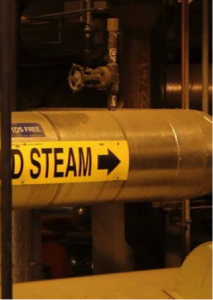
Condensed Steam Pipe in Tunnel
Although it was extremely hot, I think most of us on the field trip would agree that walking the underground tunnel across campus was definitely a highlight. Most of us on the trip had no idea that the tunnel even existed, so its discovery was definitely a surprise along with learning that it serves purposes such as a video taping location for graduation being that it passes directly underneath the green.
We encourage you to visit the Dartmouth Heating Plant sometime soon to understand first hand, the relationships that the plant holds with the Dartmouth, Hanover, and New England communities!
For information regarding steam tunnel tours please visit: http://dartmouth.edu/events/event?event=27995#.VXDzzkvNUds



